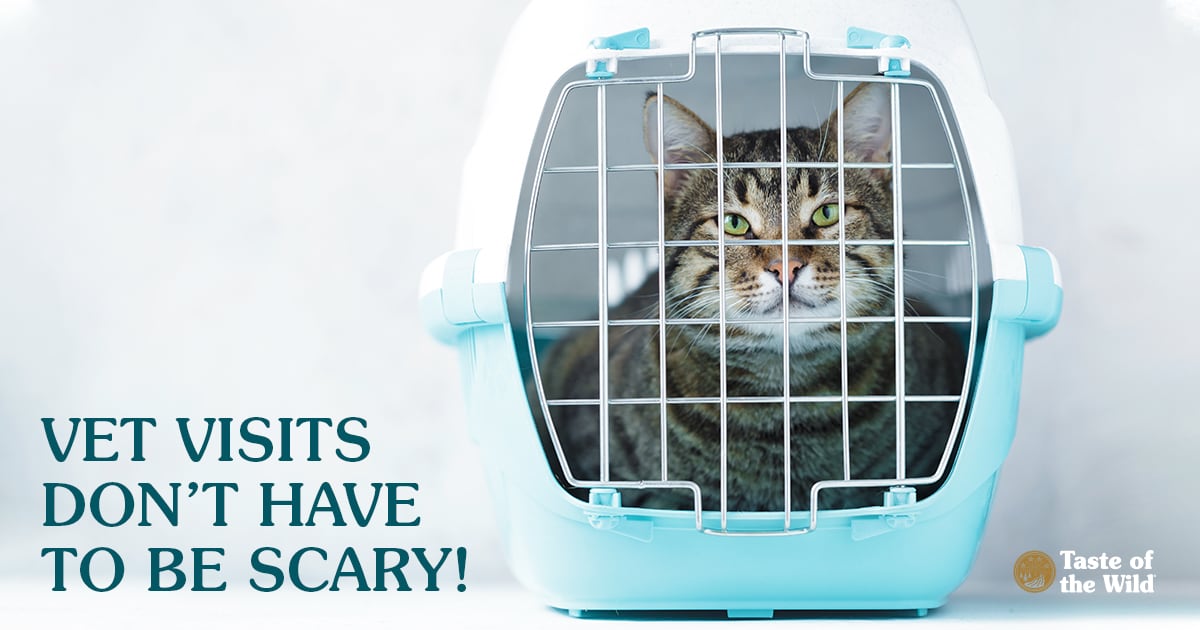
“White coat syndrome” is a very real phenomena. For people who suffer from this disorder, the mere sight of a doctor — usually clad in a white lab coat — is enough to send their blood pressure skyrocketing. A similar thing can happen to cats, too. The stress of a trip to the vet can lead to caterwauling during the car ride and the uncanny ability to brace their paws inside the carrier, defying extrication.
Maybe that’s why 52 percent of cat owners claim their cats hate going to the veterinarian. And 38 percent of cat owners claim that just thinking about their cat at the vet made them feel stressed.
The result of these fears? Cats often don’t get the important health care they need. That’s why, as part of National Take Your Cat to the Vet Day on August 22, we’re sharing tips to help make vet visits less stressful for you and your cat.
Start preparing weeks before the appointment
It’s simply safer for you and your cat if they are in a carrier for the trip to and from the clinic. The carrier should be large enough to allow your cat to stand up and turn around inside. Ideally, the carrier should have a removable top, whether it’s a hard-plastic model that can be unscrewed or a soft-sided carrier with a zipper at the top.
If you already have a carrier, there’s a good chance that the sight of it is a cue for your cat to bolt under the bed — especially if your cat only associates negative experiences with it, such as trips to the veterinarian or the groomer. But now’s your chance to change that.
Make the carrier hard to resist
About a month before your appointment, start associating all things positive with the carrier.
Remove or open the top and place your cat’s favorite blanket inside, or an article of your clothing that carries your scent. Cat pheromones, which can make cats feel calmer, are another option for spraying on the blanket. Then place the lower portion of the carrier in a room the cat frequents, and leave it there so the cat can explore it at their leisure.
Scatter treats, catnip or toys in the carrier to make it even more enticing. You can also start to feed your cat outside the carrier and gradually, over the course of a few days, move the food bowl inside.
After your cat is comfortable being in the bottom part of the carrier, add the top, or zip the top closed, but leave the door open so your cat can come and go. Once your cat is comfortable with that, try closing the door for short periods of time and drop high-value treats inside so your cat associates awesome things with the carrier.
Help your cat become accustomed to the car
Now that your cat is comfortable in the carrier with the door closed, pick up the crate and carry it a few feet so your cat gets used to that feeling. Gradually increase the distance until you can place the carrier in the car.
Secure the carrier with a seat belt or other means so it doesn’t slide around. Drop a few treats in the carrier and start the car, let it idle for a short period, then stop. For some cats, it helps to drape a light blanket or towel over the carrier, so they aren’t scared by unfamiliar sights. The next day, take a trial drive around the block and gradually increase the length of your drive.
Schedule happy veterinary visits
Call your veterinary clinic and see if you can schedule a few “happy” visits for your cat. These are five- or ten-minute visits during which clinic staff brings your kitty into an exam room and delivers treats in a calm setting. This will help your cat adjust to the sights and smells of the clinic and associate positive feelings with it.
When it comes time for your cat’s actual appointment, rest assured that many clinics have “cat only” exam rooms, or spray cat-friendly pheromones in rooms, and know stress-free handling techniques to make your cat more copacetic with the visit. Depending on your cat’s medical condition, your veterinarian may be able to follow up with you over the phone or by video conference.
Finally, if your cat is still severely stressed, ask your veterinarian for a sedative medication that can be given to your cat a few hours before the appointment. Or you can consider working with a veterinarian who does house calls.
With a little help, your cat can learn that a veterinary visit doesn’t have to be scary. That, of course, can make your life a lot easier, too. And you can feel gratified that you’re providing your cat with the health care that could enhance and even extend his or her life.
The information in this blog has been developed with our veterinarian and is designed to help educate pet parents. If you have questions or concerns about your pet's health or nutrition, please talk with your veterinarian.
